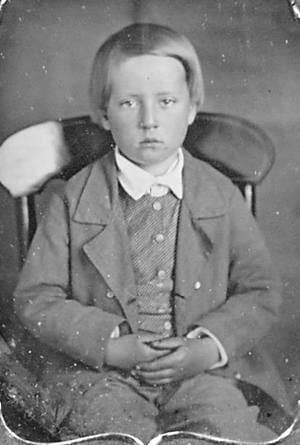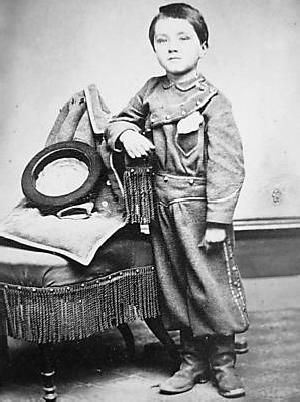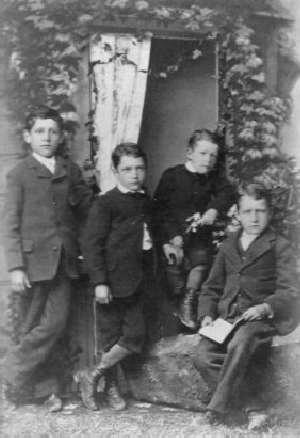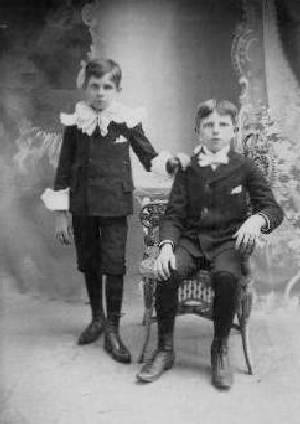
Boys' Pants and Trousers Chronology: 19th Century--Decade Trends
Boys in the early 19th century mostly wore long pants. Knee-length pants become common in England during the late 1850s and early 1860s. Knee-length pants become common in England during the
late 1850s and early 1860s. Knee pants by the late 1860s had spread
to America, especially among affluent families in the major cities. A good example here is an English family with the boys wearing suits wth cut-away jackets and bloomer knickers. The knee pants became closer fitting, appearing almost
like knee breches. A Lord & Taylor' catalog for 1881 showed various juvenile styles for boys up to 11, but jackets and suits with pants cut off at the knees for boys from 5-12. Longpants suit were available for boys beginning at 10. Often the legs were slped for a close fit below the knee, Knee pants still commonly appeared as trousers cut off at the knees, according to Woman's World in 1888. As the decade progressed, knee pants were increasinly worn by older boys. The fashion magazine The Delineator describes knee
pants suits for boys up to 16 years.
The 1800s
Boys in the early 19th century mostly wore long pants. Skeleton suits with long pants were the stylish outfits for boys. Men especially influential men still wore knee breeches. Some boys from aristocratic families might have worn kneebreeches, but even here skeleton suits with long pants were very common.
The 1810s
The 1820s
The 1830s
Skeleton suits began to go out of style in the 1830s. Nost boys, however, after breeching wore long pants.
The 1840s
Most boys wore long pants suits in the 1840s. A good example is an English boy in 1844 wearing a long pants suit with a brightly colored vest (waistcoat). y boys wore suits with trousers that did mot match the jacket. A good example is an unidentified American boy, probably in the 1840s.

Figure 6.--We note several different portrait types in the 1850s. This one was a Daguerreotype. Almost all of the portraits we have found show boys of all ages wearing long pants after breeching. Shortened-length pants were worn, but the photographic record suggests that they were not very common. They seem to have been restricted to fashionably families in the big northeastern cities most influenced by European families.
|
|
Almost all of the portraits we have found show boys of all ages wearing long pants after breeching. Shortened-length pants were worn, but the photographic record suggests that they were not very common. They seem to have been restricted to fashionably families in the big northeastern cities most influenced by European families.Younger boys from affluent families might wear tunics, at first with pantalettes and then with kneepants. Slightly older boys wore Knee-length pants in America and Europe during the late 1850s and early 1860s. This was most common with affluent, urban families with fashion concious mothers. Long pants suits were much more common. Most boys wore long pants suits. We have archived many examples of this. Long pants were even common for younger boys. We see boys of all ages wearing long pants, including boys that have just been breeched.
A good example is an unidentified American boy. There are many other examples of boys wearing long pants during the 1850s. We note E.V. Grisen, an American boy. We notice many boys wearing jackets and pants in contrasting colors, often with brightly colored vests (waistcoats ). A good example is an English boy in 1851. We also notice P.H. Keely, an American boy. We note an unidentified American boy wearing button-on long pants about 1850. All older boys wore long pants. We note two London teenagers wearing Eton suits with long pants.

Figure 7.--We see younger boys more commonly wearing shortened-length pants in the 1860s. Knee pants were most common, but we see bloomer knickers as well. Most boys, however, wore long pants. This American boy was from Little Falls, New York.
|
|
We have mnuch more information on fashion during the 1860s than than any other previos decade. This was not only because of the popularity of the new CDV format, but because pf posing trends. Most Daguerreotype subjects were posed sitting down because of the long exposure times required. The Daguerreotypists thus usually centered the portaits on closeups of the subjects torsos. Ambrotypes followed the same comventions. The CDV albumen prints had shorter exposure times and thus standing portraits were more common. And for some reason the photographer backed off and full figure portraits were much mofe common. This we see full outfits, including the boys' trousers and shoes. Most boys in the 1860s wore long trousers. Suits with long trouers were very common, even for younger boys recently breeched. While virtually all olde boys wore long pants, quite a few younger boys wore shortened-length pants. Some younger boys migh wear shortened-length pants, but it was by no means universal. . Knee-length pants become common in England for younger boys during the late 1850s. This trend was even more pronounced in the 1860s. Knee pants by the late 1860s had spread to America, especially among affluent families in the major cities. It was less common in rural areas and America was still a largely rural country. A good example here is an English family with the boys wearing suits wth cut-away jackets and bloomer knickers. This trend was also seen on the Contient, aespecially fashionable France. The strength of this trend varied from country to country. Age was a major factor. Knee pants and bloomer jknickers were only worn by younger boys. Most boys by 10 years of age or earlier wore long pants. Away from fashionable cities, even younger boys wore long pants.

Figure 8.--Shortened-length pants becane increasingly common in the 1870s, but only for younger boys. Most boys continued to wear long pants like the two older boys here. We are not sure what country is represented here, but we think England. Thestudio is Miltz & Overton.
|
|
We see more boys wearing kneepants in the 1870s, especially boys from styling city families. Long pants were still commonly worn by older boys. And we see younger boys wearing them as well. A good example is Elmer Dayton in 1870. But increasingly during the 1870s more an more younger boys were wearing knee pants. Knee pants in the 1870s became closer fitting, appearing almost like knee breaches. In about 1875 we see that in America the sailor suit with knee pants had begun to be worn. The example here shows the knee pants with the sailor striping around the leg near the hem. This seems to be a hold over from the fancy suits for boys worn in the 1850s and 60s. We do not normally see this by the 1880s. Kneepants also had the ornamental three buttons, a hold-over from the buttons on knee breeches but now non-functional. The knee pants are long enough to cover the boy's knee when the lad is standing but show the knee when he is sitting. Knee pants were almost always worn with standard black stockings, held up either with round garters or, with increasing frequency, with elastic supporters suspended from a waist. We also see boys wearing bloomer knickers. This seems more common in Europe than America. A goof example is a German boy.

Figure 9.--
|
|
The 1880s
Kneepants became increasingly worn by boys in the 1880s. Ther were not, however, commonly worn by older boys. A Lord & Taylor' catalog for 1881 showed various juvenile styles
for boys up to 11, but jackets and suits with pants cut off at the knees
for boys from 5-12. Longpants suit were available for boys beginning at 10. Often
the legs were slped for a close fit below the knee, Knee pants still commonly appeared as trousers cut off at the knees, according to Woman's World in 1888. As the decade progressed, knee pants were increasinly worn by older boys.
Carson Agnew wore a knee pants suit in the 1880s, again with the traditional
long black stockings. Notice that the knee pants come down over his knee. And
again we have the three ornamental buttons at the knee. Another American boy
of the same decade wore a Norfolk-styled suit with knee pants and a very large
bow. Photographic portraits show that knee pants were beginning to be worn
by older boys--including boys into their teen years. Still another photo shows an
American boy of probably 14 wearing a knee pants suit. (See figure 3 on the
main knee pants page).
Some knee pants during the 1880s were still worn quite long. Notice a photo of
Ralph Hunter Cummings, from New York state, whose knee pants come down almost
to his shins, but the convention of just below the knnes was becoming standard.
Although knee pants were becoming popular for boys, they had by no means
completely replaced long trousers. In England we notice the Brown boys dressed in sailor suits with long pants, worn even by younger children. This became an anomally. Sailor suits were made with both long pants and kneepants. For some boys their first long psnts came with their sailor suits. There was still considerable variation in the 1880s, even among affluent families. An example here is a 1886 a portrait of Coley Collins, an American boy of about 10 or 11, wearing a long pants suit. There were differences among countries as well as social class. Boys from rural areas and the urban working class were less likekly to wear kneepants than middle-class urban families

Figure 10.--These brothers from Williamston, Michign in the 1890s both wear knee pants suits with long stockings. Earlier the older brother was more likely to wear long pants. Note the younger boy's ruffled Fauntleroy collar.
|
|
The 1890s
European and American boys by the 1890s were wearing knee pants almost
de rigeur, at least in families that made any pretension to fashionability and by many who did not. We see them being worn throughout Europe and North America and by older boys as well as boys from a wider social-economic cross section.
In Germany, for instance, we see a boy wearing a light-colored sailor suit
made of velvet. It has knee pants with the ornamental buttons, but the pants
are still long enough to cover the knees.
The fashion magazine The Delineator describes knee
pants suits for boys up to 16 years. Here we see an American boy wearing a kneepants suit with Norfolk styling. Kneepants were the predominant style for American boys in the 1890s. Not all boys wore jneepants, we see some boys with long panrs suits, but kneepants were more common. This varied frm country to country. We also note knnepanrs being widely worn in Europe, but various styles of knickers were also worn. We notice both single and double breasted jackets. We have not yet noted if the style of jacket affected the type of pants.
In the United States, during the same period, we note an American boy from
Virginia wearing a knee pants suit that had somewhat shorter trousers--
trousers that expose the knees, at least when the boy is sitting down to play
the banjo. As the decade wore on, it seems to have been thought more
fashionable--and perhaps more boyish as well--to make the knee pants somewhat
shorter. Another American example is a younger teenager in 1893.
The shorter knee pants become more obvious in a school photo taken in New York
State about 1895 of the Misses Porter School. Here the boys--even older boys--
are wearing their knee pants well above the knee so that the knee pants begin
almost to resemble short trousers. The dressy ornamental buttons at the knee
seem to have disappeared in this exposure. But note that at least one of the
boys (to the extreme left in the complete photo--necessary to click here) is
wearing a dressy double breasted suit with knee pants.
See also the photograph of A. Balfour, a boy from Montreal, whose formal
protrait shows him wearing knee pants that are at least four inches above the
knee. The elaborate lace shirt and the very tight but plain knee pants worn
with black stockings make Master Balfour look especially elegant. This
picture is dated 1898. Another portrait from Montreal, of M. E. Beckett taken
in 1899, shows an older teenager wearing a very grown-up knee pants suit with
a gold watch chain and a stiff collar and tie. In fact the only feature of
this boy's clothing that is not adult is the knee pants. The pants are
somewhat longer in the older boy's case than was normal with younger boys, but
the knee is still exposed in the sitting position. Another Canadian knee pants
suit (1897) is a very sporty checked double breasted affair worn with a classy
bow tie by E. Masson (Montreal).
HBC

Navigate the Historic Boys' Clothing Web Site:
[Return to the Main 19th century trouser chronology page]
[Introduction]
[Activities]
[Biographies]
[Chronology]
[Cloth and textiles]
[Clothing styles]
[Countries]
[Topics]
[Bibliographies]
[Contributions]
[FAQs]
[Glossaries]
[Satellite sites]
[Tools]
[Boys' Clothing Home]
Navigate the Historic Boys' Clothing Web chronological pages:
[Early 19th century]
[Mid-19th century]
[The 1860s]
[The 1870s]
[The 1880s]
[The 1890s]
[The 1900s]
[The 1910s]
[The 1920s]
[The 1930s]
[The 1940s]
[The 1950s]
[The 1960s]
[The 1970s]
[The 1980s]
Navigate the Historic Boys' Clothing Web style pages:
[Skeleton suits]
[Eton suits]
[Norfolk jackets]
[Kilts]
[Knicker suits]
[Blazers]
[Short pants suits]
[Long pants suits]
Created: 12:27 AM 4/3/2006
Last updated: 1:40 AM 5/20/2008






